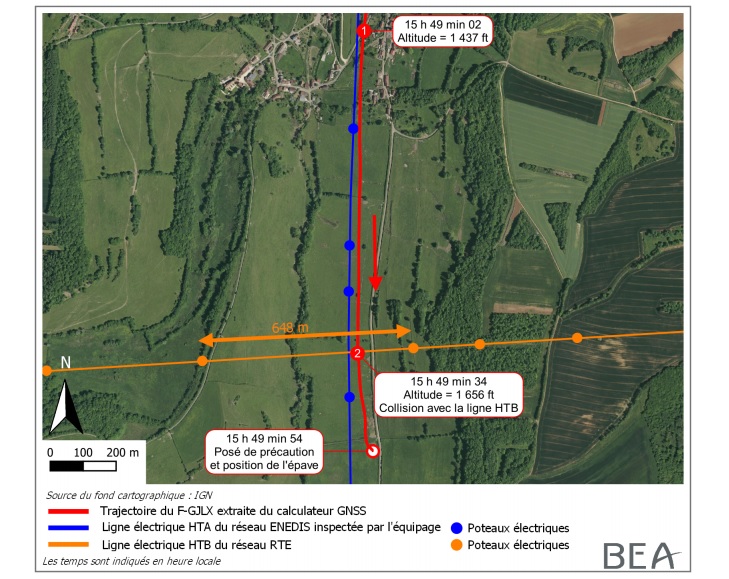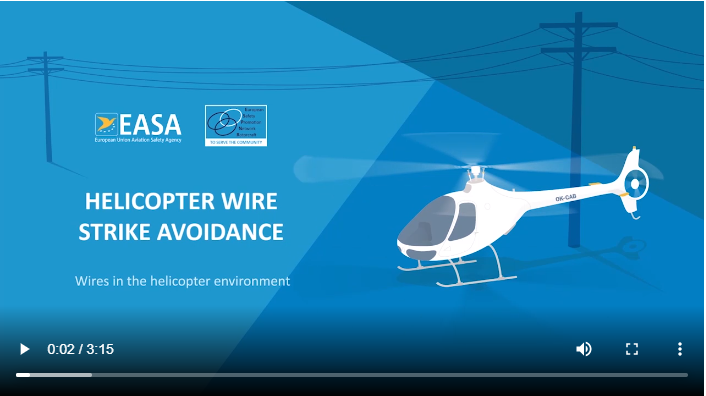Crossing Cable Wirestrike (JSHS MD369D F-GJLX)
On 16 October 2019 Jet Systems Helicopters Services (JSHS) Hughes / MD 369D (500D) F-GJLX was conducting an inspection of medium voltage electric power lines near Blancey for utility company Enedis (part of EDF) when it suffered a wire strike with a crossing high voltage cable. The French Bureau d’Enquêtes et d’Analyses pour la Sécurité de l’Aviation Civile (the BEA) explain in their safety investigation report (issued 18 September 2020 in French) that it was late afternoon and a team of 3 (a pilot, a systems operator in the front right seat from specialist company Visimind and a technical observer in the rear right seat) were making their third flight of the day. The pilot…
…had a total experience of 2,862 flight hours including 168 on the Hughes 500. He had started surveillance missions in April 2019 and had a total of 300 flight hours in this area.
The systems operator had started training in October 2018 when he was recruited.
He also completed a 5-day training course at JSHS in January 2019, leading to a practical exam and a certificate issued by Enedis.
He had a total of 150 hours experience with the Hughes 500 and Robinson R44.
The technical observer had 1,200 hours of experience, including 800 on the Hughes 500.
They were using both a camera and LIDAR to survey vegetation surrounding the power line. Such operations are usually conducted offset to the left of the cable, c15-50 ft above at very low speed (just c 10-30 knots). Unlike the other 369D in JSHS’ fleet, F-GJLX was not fitted with a wire strike protection system (WSPS).
The pre-flight briefing…(as well as the entire mission) was carried out in English because the systems operator was of Polish nationality.
Although the trio had not flown together before they reported no problems of comprehension. The technical observer did comment however that there was less dialogue that normal though between pilot and systems operator (who was effectively the navigator for this type of task).
The crew planned the mission by also taking into account Enedis’ recommendation to limit themselves to a maximum of six flight hours per day.
The briefing was conducted with a map in order to decide on the route and to visualize the various obstacles. The systems operator proposed a route, which the captain asked to do in the opposite direction to better take into account the meteorological situation over the entire trip (sunshine, cloudiness, wind).
Although the aircraft maintained a safe distance from the power line being inspected (shown in blue below) its main rotor struck a perpendicular crossing power line (shown in orange).
The pilot did not see the line before hitting it, due to a low contrast between the High Tension line and the surrounding space making it difficult to detect cables and an absence of metal support in his field of vision. On the section of line inspected during the collision, the sun was slightly head-on but not dazzling.
The pilot made a precautionary landing 20 seconds later. The canopy was damaged and there was also electrical arcing damage.
The crew demonstrated excellent teamwork by holding an immediate hot debrief.
The crew observed that although the crossing cable was charted the mapping system (shown below) the system was zoomed in on the cable being inspected (shown in blue) and so the crossing cable (in red) would have only been shown very late.
The systems operator explained that he was more used to inspecting longer, straighter cables and had needed to zoom in on the cable being inspected because its more complex routing to ensure no branches were missed. Although the BEA don’t elaborate its possible that the systems operator was suffering from some degree of task saturation.
The pilot however pointed out that it was usual for the systems operators to announce obstacles 3 towers or 300 m in advance.
There is no mention of marking power lines with warnings of crossing cables as discussed here: Helicopter Wirestrike During Powerline Inspection
BEA Analysis of Contributory Factors
- Inadequate management of the tools made available for monitoring the line and neighbouring networks.
- An insufficient pre-flight briefing as to the reminders to be carried out on the obstacles foreseen during navigation.
- The difficulty of detecting power lines when flying into the sun in an environment with little contrast, and poles that do not reflect light.
- In addition, the posts were not in the pilot’s field of vision and were spaced more than 600 m apart.
Safety Resources
We have written on previous wirestrikes:
- Helicopter Wirestrike During Powerline Inspection which considers marking of crossing cables
- Sécurité Civile EC145 SAR Wirestrike
- Firefighting Helicopter Wire Strike
- Fatal MD600 Collision With Powerline During Construction
- Fatal Wire Strike on Take Off from Communications Site
- Beware Last Minute Changes in Plan
- Impromptu Landing – Unseen Cable
- Fatal Wisconsin Wire Strike When Robinson R44 Repositions to Refuel
- Hanging on the Telephone… HEMS Wirestrike
- UPDATE 5 March 2021: Wire Strike on Unfamiliar Approach Direction to a Familiar Site
- UPDATE 14 August 2022: Second Time Unlucky: Fatal Greek Wirestrike High-Wire Illusion
- UPDATE 3 September 2022: Garbage Pilot Becomes Electric Hooker
See also: Avoiding Wire Strikes
The European Safety Promotion Network – Rotorcraft (ESPN-R) has published this video and guidance with EASA:
We have also covered:
- Pilot Goose(d) Surprised and Crashed
- Air Ambulance Helicopter Downed by Fencing FOD
- S-92A Collision with Obstacle while Taxying




Recent Comments